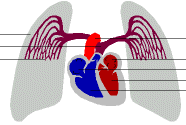|
Hazards and Complications |
|
The majority of hazards and complications associated with positive airway pressure therapy are caused by either the increased pressure or the apparatus itself. |
 |
- Due to increased pressure:
Pulmonary barotrauma
Increased intracranial pressure
Decreased venous return
Gastric distention
- Due to the apparatus:
Increased work of breathing (resistor)
Vomiting/aspiration (gastric distention + mask)
Claustrophobia (mask)
Skin break down and discomfort (mask)
Epistaxis
The equipment can cause an increase in the work of breathing leading to hypoventilation and hypercapnia. Since none of these therapeutic modalities augment spontaneous ventilation, patients with an accompanying ventilatory insufficiency may hypoventilate during application. While barotrauma is a potential hazard with any positive airway pressure therapy, no such incidents have been reported, probably due to the population of patients using such therapy, and the techniques employed.
Equipment
The equipment needed for PEP therapy includes a form-fitting face mask, a one way T-valve assembly, a pressure manometer, and an adjustable flow resistor. A mouthpiece can be used instead of a mask for some patients, and if patients require aerosolized bronchodilator therapy, a SVN can be added to the system.
There are two approaches to EPAP therapy:
- The simplest involves using the same equipment as used for PEP therapy,
but replacing the flow resistor with a threshold resistor. This type
of EPAP system requires no pressurized source gas.
- A pressurized gas source can be used to provide EPAP, with the pressurized
gas from a flowmeter flowing continuously into a large volume aerosol
generator, and into the inspiratory limb of a breathing circuit. An
aerosol reservoir, open to the atmosphere is attached to a T-piece in
the inspiratory limb of the circuit.
This reservoir provides extra volume if the patient's inspiratory flow exceeds that of the system. The patient breathes in and out through a mask attached to a T-piece. On the inspiratory side of the T-piece is a one-way inspiratory valve which allows the patient to draw gas from the inspiratory limb, but prevents exhalation back into that side of the circuit. The expiratory limb of the circuit is connected to a threshold resistor, in this case a water column.
With gas flowing continuously through the circuit, the pressure in the EPAP system is proportional to the height of the water column, and can be varied by adding or removing water from this column.
With CPAP therapy, the equipment used varies considerably in design and complexity. A breathing gas mixture from an oxygen blender flows continuously through a humidifier and into the inspiratory limb of a breathing circuit. A reservoir provides reserve volume if the patient's inspiratory flow exceeds that of the system. The patient breaths in and out through a simple valveless T-piece connector, and a pressure alarm system with manometer monitors the CPAP pressure at the patient's airway. The alarm system can warn of either low (usually due to a disconnection) or high system pressure. The expiratory limb of the circuit is connected to a threshold resistor in this case a water column.
The CPAP circuit is essentially the same as the EPAP circuit, with the exception of the closed reservoir and monitoring system. Because it is a closed system, the CPAP circuit should also have an emergency inlet valve. This emergency inlet valve ensures that atmospheric air is available to the patient should the primary gas source fail.